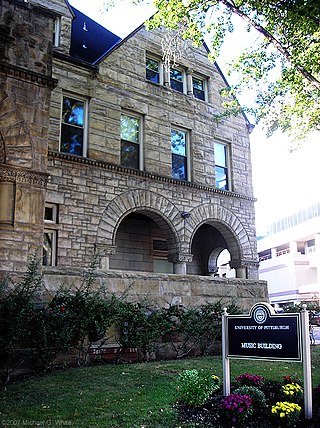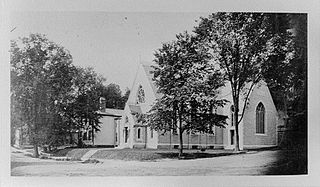
Braddock is a borough located in the eastern suburbs of Pittsburgh in Allegheny County, Pennsylvania, United States, 10 miles (16 km) upstream from the mouth of the Monongahela River. The population was 1,721 as of the 2020 census, a 91.8% decline since its peak of 20,879 in 1920.

A Carnegie library is a library built with money donated by Scottish-American businessman and philanthropist Andrew Carnegie. A total of 2,509 Carnegie libraries were built between 1883 and 1929, including some belonging to public and university library systems. 1,689 were built in the United States, 660 in the United Kingdom and Ireland, 125 in Canada, and 25 others in Australia, South Africa, New Zealand, Serbia, Belgium, France, the Caribbean, Mauritius, Malaysia, and Fiji.

Schenley Park is a large municipal park in Pittsburgh, Pennsylvania, United States. It is located between the neighborhoods of Oakland, Greenfield, and Squirrel Hill. It is also listed on the National Register of Historic Places as a historic district. In 2011, the park was named one of "America's Coolest City Parks" by Travel + Leisure.

Carnegie Museums of Pittsburgh is a nonprofit organization that operates four museums in Pittsburgh, Pennsylvania, United States. The organization is headquartered in the Carnegie Institute and Library complex in the Oakland neighborhood of Pittsburgh. The Carnegie Institute complex, which includes the original museum, recital hall, and library, was added to the National Register of Historic Places on March 30, 1979.

The Allegheny Observatory is an American astronomical research institution, a part of the Department of Physics and Astronomy at the University of Pittsburgh. The facility is listed on the National Register of Historic Places and is designated as a Pennsylvania state and Pittsburgh History and Landmarks Foundation historic landmark.
A Carnegie library is a library built with money donated by Scottish-American businessman and philanthropist Andrew Carnegie.

Allegheny Center is a neighborhood on Pittsburgh's North Side. Its zip code is 15212, and it has representation on Pittsburgh City Council by both council members for District 6 and District 1 (Northside).

The Allegheny County Courthouse in downtown Pittsburgh, Pennsylvania, is part of a complex designed by H. H. Richardson. The buildings are considered among the finest examples of the Romanesque Revival style for which Richardson is well known.

Frederick John Osterling was an American architect, practicing in Pittsburgh from 1888.

Carrie Furnace is a former blast furnace located along the Monongahela River in the Pittsburgh area industrial town of Swissvale, Pennsylvania, and it had formed a part of the Homestead Steel Works. The Carrie Furnaces were built in 1884 and they operated until 1982. During its peak, the site produced 1,000 to 1,250 tons of iron per day. All that is left of the site are furnaces #6 and #7, which operated from 1907 to 1978, and its hot metal bridge. The furnaces, designated a National Historic Landmark in 2006, are among the only pre-World War II 20th century blast furnaces to survive.

Carnegie Hall, Inc. is a regional cultural center located in Lewisburg, West Virginia, United States. It is within the Allegheny Mountains. Monroe, Greenbrier, Pocahontas and Summers Counties are included in Carnegie Hall, Inc.’s primary service area. This region encompasses approximately 2,900 square miles (7,500 km2) and 73,000 people.

The Soldiers and Sailors Memorial Hall and Museum is a National Register of Historic Places landmark that is located in Pittsburgh, Pennsylvania, United States. It is the largest memorial in the United States that is dedicated solely to honoring all branches of military veterans and service personnel.

The Carnegie Library of Homestead is a public library founded by Andrew Carnegie in 1898.

Longfellow, Alden & Harlow, of Boston, Massachusetts, and Pittsburgh, Pennsylvania, was the architectural firm of Alexander Wadsworth Longfellow Jr. (1854–1934), Frank Ellis Alden (1859–1908), and Alfred Branch Harlow (1857–1927). The firm, successors to H. H. Richardson, continued to provide structures in the Romanesque revival style established by Richardson that is often referred to as Richardsonian Romanesque.

The Braddock Carnegie Library in Braddock, Pennsylvania, is the first Carnegie Library in the United States. As such, the library was named a National Historic Landmark in 2012, following its listing on the National Register of Historic Places in 1973, and is on the Pittsburgh History and Landmarks Foundation's List of Historic Landmarks.
The Pleasant River Grange No. 492 is a historic Grange hall on Round the Island Road in Vinalhaven, Maine. Built as worker housing for a granite quarry, it was moved in 1909 to its present local for use by the local Grange chapter. It continues to be used by that organization as a community resource. It was listed on the National Register of Historic Places in 1999.

The Hubbard Free Library is the public library serving Hallowell, Maine. Built in 1879-80, it is the oldest library building in Maine built for that purpose. It was designed by architect Alexander C. Currier to resemble an English country church. Dedicated in 1880 as the Hallowell Library, it was renamed the Hubbard Free Library in 1894, after a $20,000 donation from philanthropist Thomas Hubbard. The building is a contributing property in the Hallowell Historic District.
The Vinalhaven Public Library is the public library serving the island community of Vinalhaven, Maine. It is located at 6 Carver Street in downtown Vinalhaven, in a small architecturally distinguished Prairie School building built in 1906 with financial support from Andrew Carnegie. The building was listed on the National Register of Historic Places in 1989.

The Moses Webster House is a historic house at 14 Atlantic Avenue in Vinalhaven, Maine. It was built in 1873 for Moses Webster, owner of one of Vinalhaven's granite quarries, and is one of the community's finest examples of Second Empire architecture. It was listed on the National Register of Historic Places in 1998.


























